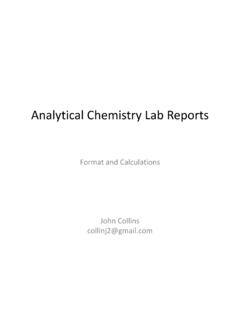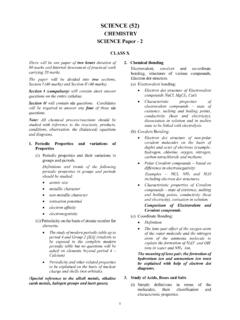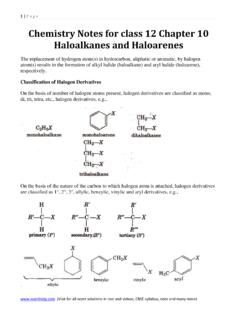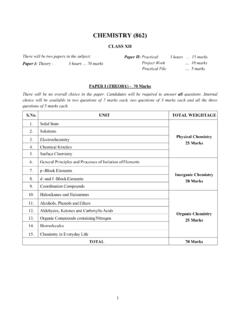Transcription of CLASS - XII CHEMISTRY Metallurgy - Yola
1 CLASS - XII CHEMISTRY . (General principles and processes of isolation of elements). Topic :- Occurrence of metals, concentration methods Metallurgy : The scientific and technological process used for isolation of the metal from its ores is known as Metallurgy . Gangue: The earthly or undesired materials which are contaminated with the ore are called gangue. Minerals: They are the naturally occurring chemical substances in the earth's crust obtainable by mining. Ores: The mineral from which the metals can be economically and conveniently extracted is called an ore. The most abundant metal is Aluminum & second most abundant metal is iron Give some important ores of Aluminum, Iron, Copper and Zinc The extraction and isolation of metals from ores involve the following major steps: Concentration of the ore, converting ore into oxide Reduction Refining (Purification of the metal.). Concentration of the ore/ dressing or benefaction: The process of removal of the unwanted materials ( , sand, clays, etc.)
2 From the ore is known as concentration, dressing or benefaction Different methods of concentrations: Hydraulic Washing, magnetic separation, leaching, Froth Floatation. Hydraulic Washing/ gravity separation: Principle: This is based on the differences in gravities of the ore and the gangue particles. In this process, an upward stream of running water is used to wash the powdered ore. The lighter gangue particles are washed away and the heavier ores are left behind. This method is frequently used when the ore particles are heavier than the earthly or rocky gangue particles. It is commonly used for oxide ores such as haematite, tin stone and native ores of Au, Ag. Magnetic separation: Principle: This is based on differences in magnetic properties of the ore components (Ore & gangue). If either the ore or the gangue (one of these two) is capable of being attracted by a magnetic field, then such separations are carried out .the ground ore is carried on a conveyer belt which passes over a magnetic roller.
3 Magnetic particles form a separate heap near the magnetic roller. Which of the ores mentioned in Table can be concentrated by magnetic separation method? Iron ores such as Hematite, Magnetite concentrated by magnetic separation method Leaching/chemical separation: Leaching is often used if the ore is soluble in some suitable solvent. Leaching of alumina from bauxite: The principal ore of aluminum is bauxite which contains SiO2, iron oxides and titanium oxide (TiO2) as impurities. Concentration is carried out by digesting the powdered ore with a concentrated solution of NaOH at 473 523 K and 35 36 bar pressure. This way, Al2 O3 is leached out as sodium aluminate (and SiO2 too as sodium silicate) leaving the impurities behind: The aluminate in solution is neutralized by passing CO2 gas and hydrated Al2 O3 is precipitated. At this stage, the solution is seeded with freshly prepared samples of hydrated Al2 O3which induces the precipitation: The sodium silicate remains in the solution and hydrated alumina is filtered, dried and heated to give back pure Al2 O3: Significance of leaching in the extraction of aluminium Leaching is significant as it helps in removing the impurities like SiO 2, Fe2O3, etc.
4 From the bauxite ore. Leaching Gold and Silver In the Metallurgy of silver and that of gold, the respective metal is leached with a dilute solution of NaCN or KCN in the presence of air (for O2) from which the metal is obtained later by replacement: (Mac Arthur Forest Cyanide Process). The role of NaCN in gold extraction In the Metallurgy of silver and that of gold, the respective metal is leached with a dilute solution of NaCN. Froth Floatation method: Principle: The mineral particles are wetted by oil while the gangue particles are wetted by water This method has been in use for removing gangue from sulphide ores. In this process, a suspension of the powdered ore is made with water. To it collectors and froth stabilizers are added. Collectors- pine oil, fatty acids, xanthates, non-wettability of the mineral particles Froth stabilizers cresols, aniline, etc. - stabilise the froth. The mineral particles are wetted by oil while the gangue particles are wetted by water. A rotating paddle agitates the mixture and draws air in it.
5 As a result, the froth is formed which carries the mineral particles. The froth is light and is skimmed off. It is then dried for recovery of the ore particles. The role of a depressant in the floatation process Depressant selectively prevents one of the sulphide ore coming to froth by complexation NaCN is used as depressant when ore containing ZnS and PbS , it selectively prevents ZnS from coming to the froth but allows PbS to come with the froth Topic:- Extraction of crude metal from concentrated ore Calcination: Calcinaton is a process of heating the ore strongly either in a limited supply of air or in the absence of air. During this process the following changes take place: The volatile matter is removed. Moisture is removed. Water from the hydrated oxides is removed. The ore becomes porous. Carbonates decompose to oxides. Roasting: Roasting is the process of heating the ore strongly in the presence of excess or regular supply of air in a furnace at a temperature below the melting point of the metal.
6 Sulphide ores roasted Reduction of oxide to the metal: Reduction of the metal oxide usually involves heating it with some other substance acting as a reducing agent (C or CO or even another metal). The reducing agent ( , carbon) combines with the oxygen During reduction, the oxide of a metal decomposes: Some metal oxides get reduced easily while others are very difficult to be reduced (reduction means electron gain or electronation). In any case, heating is required. To understand the variation in the temperature requirement for thermal reductions (pyrometallurgy) and to predict which element will suit as the reducing agent for a given metal oxide (M xOy), Gibbs energy interpretations are made. Basic concepts of thermodynamics help us in understanding the theory of metallurgical transformations. G for any process at any specified temperature, is described by the equation: Where, H is the enthalpy change and S is the entropy change for the process. For any reaction, this change could also be explained through the equation: Where, K is the equilibrium constant of the reactant product' system at the temperature, T.
7 A negative G implies a +ve K and this can happen only when reaction proceeds towards products. From these facts we can make the following conclusions: 1. When the value of G is negative in equation , only then the reaction will proceed. If S is positive, on increasing the temperature (T), the value of T S. would increase ( H < T S) and then G will become ve. 2. If reactants and products of two reactions are put together in a system and the net G of the two possible reactions is ve, the overall reaction will occur. So the process of interpretation involves coupling of the two reactions, getting the sum of their G and looking for its magnitude and sign. Such coupling is easily understood through Gibbs energy ( G ) vs T plots for formation of the oxides Ellingham diagrams: Ellingham diagrams are graphical representation of variation of G vs T for the formation of oxides of elements , for the reaction One limitation of Ellingham diagrams. Ellingham diagrams only tell us about the feasibility of a reaction.
8 They do not tell anything about the reaction kinetics. Below G formation of oxide values are more negative it is better reducing agent at that temperature . Thermodynamics helps us to understand how coke reduces the oxide It can be seen as a couple of two simpler reactions. In one, the reduction of FeO is taking place and in the other, C is being oxidized to CO: When both the reactions take place to yield the equation the net Gibbs energy change becomes: . At temperatures above 1073K (approx.), the C, CO line comes below the Fe,FeO line [ G. (C, CO) < G(Fe, FeO)]. So in this range, coke will be reducing the FeO and will itself be oxidised to CO. The reaction, is thermodynamically feasible as is apparent from the Gibbs energy value. Why does it not take place at room temperature? Certain amount of activation energy is essential even for such reactions which are thermodynamically feasible, therefore heating is required. Is it true that under certain conditions, Mg can reduce Al2O3 and Al can reduce MgO?
9 What are those conditions? Yes, below 1350 C Mg can reduce Al2O3and above 1350 C, Al can reduce MgO. Out of C and CO, which is a better reducing agent at 673 K? At 673 K, the value of Gf (CO,CO2)is less than that of Gf (C,CO). Therefore,CO is a better reducing agent than C. Why is zinc not extracted from zinc oxide through reduction using CO? Gf (Zn,Zno) value more negative (lower) than Gf (CO,CO2) Therefore, CO cannot reduce ZnO to Zn. Hence, Zn is not extracted from ZnO through reduction using CO. Out of C and CO, which is a better reducing agent for ZnO ? C is a better reducing agent for ZnO because at higher temperature (above 1073k) G f (C,CO) is more negative than Gf (Zn,Zno). On the other hand, Gf (CO,CO2) is always higher than Gf (Zn,Zno) Therefore, CO. cannot reduce ZnO. Hence, C is a better reducing agent than CO for reducing ZnO. The value of for formation of Cr2O3 is 540 kJmol 1 and that of Al2 O3 is 827. kJmol 1. Is the reduction of Cr2O3 possible with Al? The value of for the formation of Cr2O3 from Cr ( 540 kJmol 1) is higher than that of Al2O3 from Al ( 827 kJmol 1).
10 Therefore, Al can reduce Cr2O3 to Cr. Hence, the reduction of Cr2O3 with Al is possible. Alternatively, Subtracting equation (ii) from (i), we have As G for the reduction reaction of Cr2O3 by Al is negative, this reaction is possible Topic:- Oxidation Reduction; Refining. 1. Give an example of extraction based on oxidation reduction. An example based on extraction by oxidation is extraction of chlorine from brine. 2. How are gold and silver extracted? Gold and silver are extracted by leaching the metal with NaCN-. The metal is later recovered by displacement method in which zinc acts as reducing agent. Refining: A metal extracted by any method is usually contaminated with some impurity. The process of obtaining high purity metal from impure metal. Methods of refining : (a) Distillation (b) Liquation (c) Electrolysis (d) Zone refining (e) Vapour phase refining (f) Chromatographic methods (a) Distillation: This is very useful for low boiling metals like zinc and mercury. The impure metal is evaporated to obtain the pure metal as distillate.
![[CLASS XII CHEMISTRY PRACTICALS] - Saint John's Senior ...](/cache/preview/8/e/c/c/7/0/2/b/thumb-8ecc702b441a6099d9810dbf9f2c3c2f.jpg)







